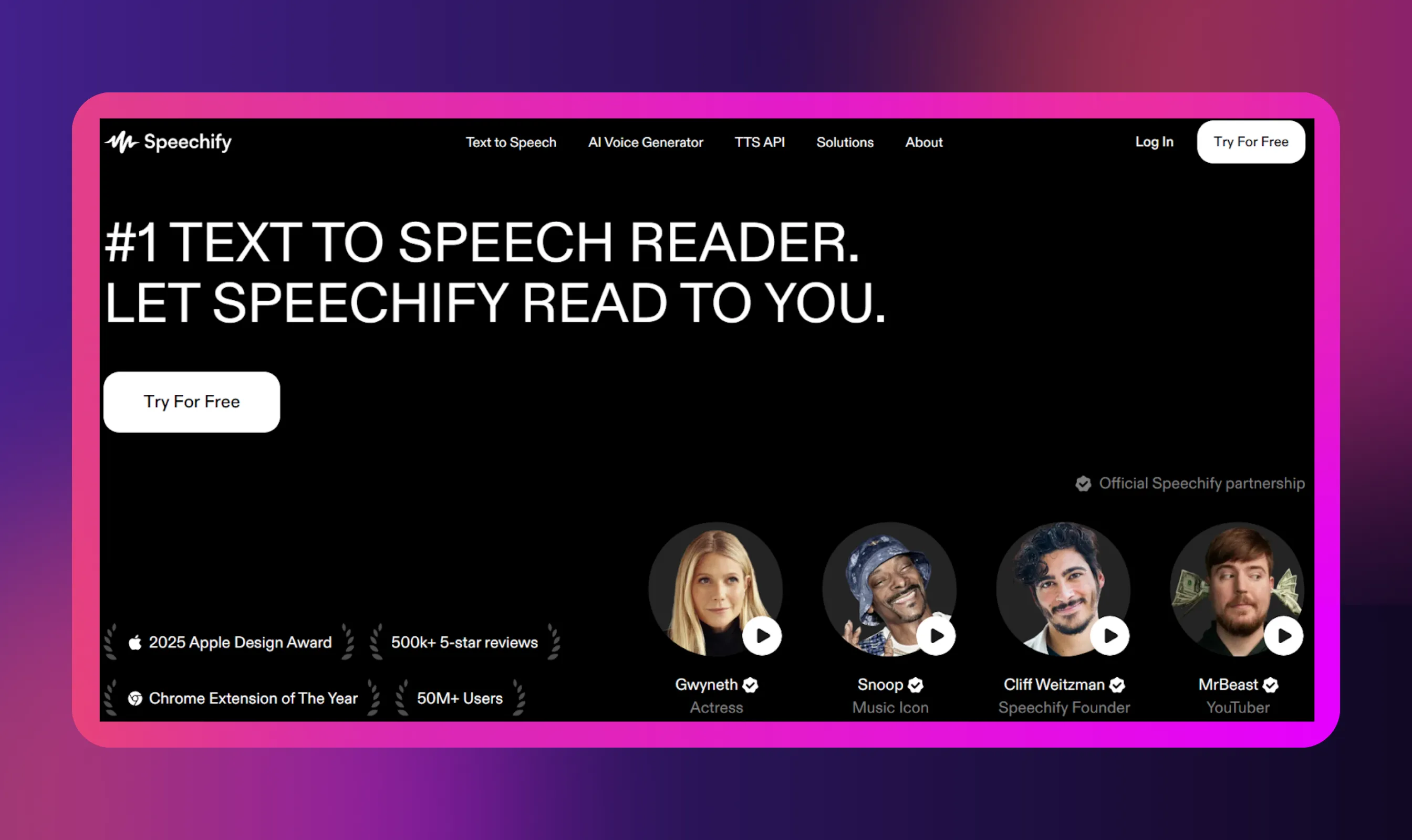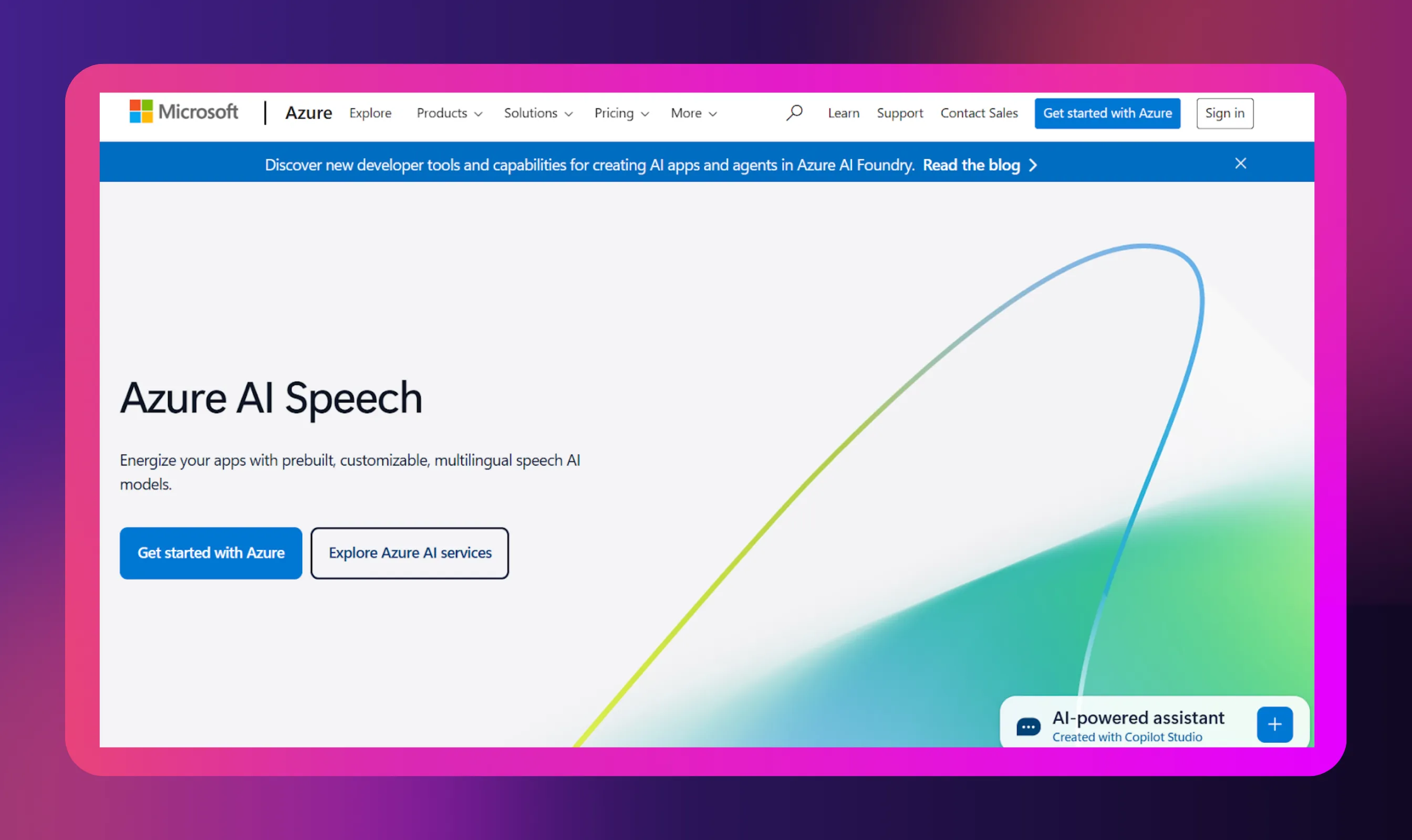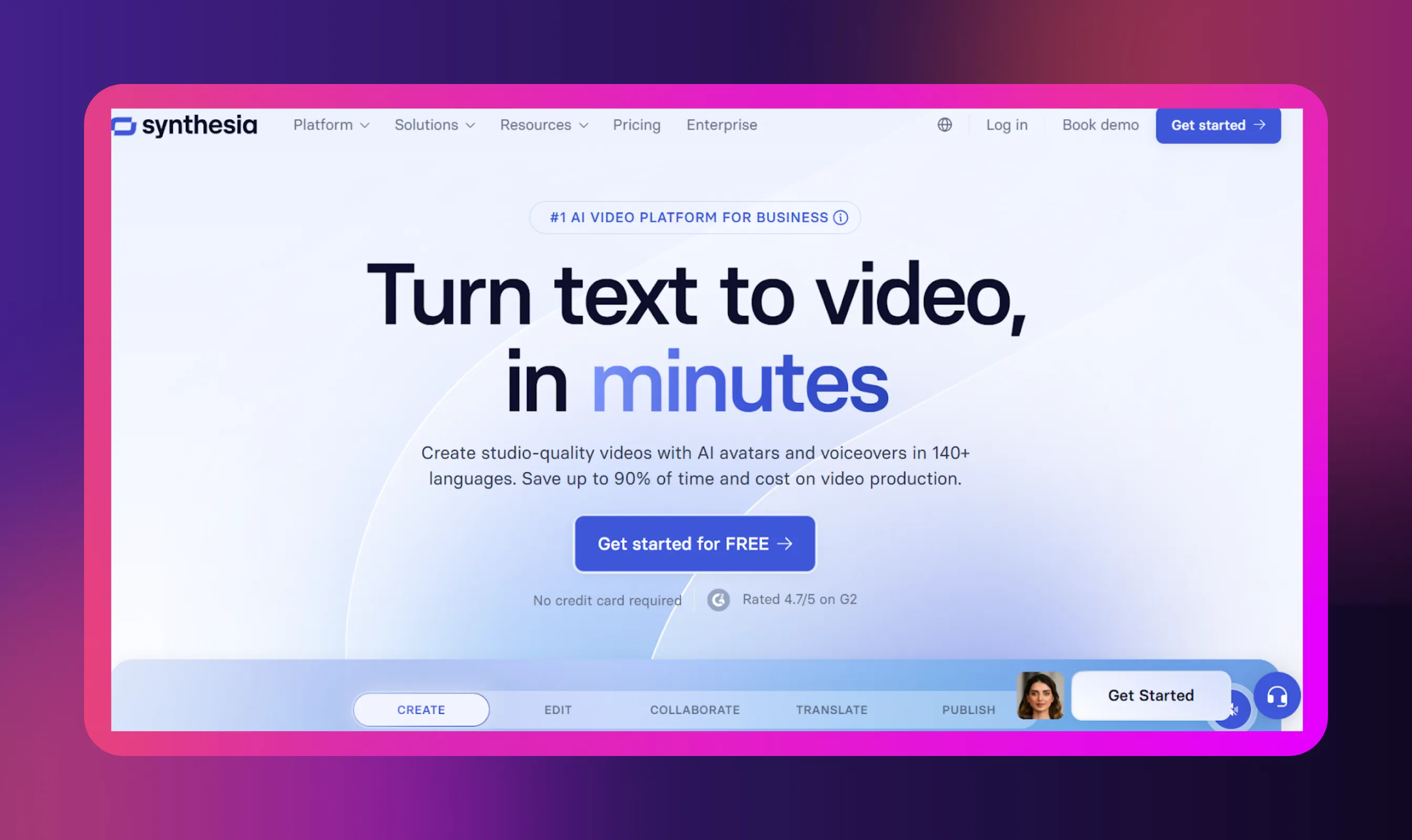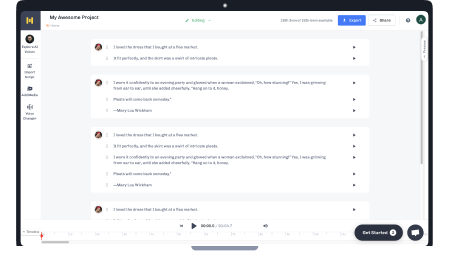10 Best Cartesia Alternatives: Top AI Voice Tools Compared

Text to speech (TTS) technology has evolved from robotic tones to lifelike speech that feels real and engaging, powered by artificial intelligence .
With options ranging from advanced customization to premium features like emotion control, regional accents, and seamless integration, the demand for high-performing AI voice technology is growing fast.
While Cartesia has made a mark in speech technology, many are searching for Cartesia alternatives that deliver superior voice quality, a user-friendly interface, and an innovative AI platform with a flexible pricing structure. These tools simplify content creation, support video editing, and enable global audiences to access AI generated voices for e-learning, video content, and creative projects.
In this article, we’ll explore the top 10 alternatives to Cartesia, starting with Murf as the ultimate text to speech tool.
Why Consider AI Alternatives to Cartesia?
Cartesia has gained attention in the AI voice technology space, but as a relatively new entrant (it was launched in 2023), it comes with limitations that may not suit every user. For example, its voice catalog is still smaller compared to established text to speech tools that offer vast libraries of natural sounding speech and regional accents.
Businesses that need a consistent brand voice across different markets may find Cartesia’s AI voice options limited in terms of extensive customization and advanced AI features like emotion control or seamless integration with existing workflows.
Another consideration is scalability. While Cartesia shows promise, larger organizations or small businesses aiming for large scale deployments often require technical expertise, robust support, comprehensive documentation, and flexible pricing structures. These are areas where more established platforms offering custom solutions have an edge.
Choosing Cartesia alternatives allows companies to tap into proven quality, deeper voice customization, and user-friendly tools that simplify content creation, video editing, and delivering professional-quality videos for global audiences.
Top 10 Cartesia Alternatives
1. Murf AI

Murf is positioned as the primary alternative that Cartesia users might really migrate toward. Here are some key features that set it apart:
- Voice quality & natural sounding voices: Murf offers over 200 voices in 40+ languages, with emotional nuance, pitch, pause, emphasis control, and excellent pronunciation accuracy (99.38 %).
- Customization & voice cloning/voice changer: You can record or clone your voice, or modify pitch, prosody, emphasis, and so on.
- Seamless integration & API access: Murf supports embedding in Canva, PowerPoint, Adobe Audition, and Webflow, and offers a full developer API/SDK ecosystem.
- Pricing & scalability: It provides a free tier plus paid plans. Paid plans start from $19/month. Custom plans are also available.
What differentiates it from Cartesia:
- Murf offers 200+ ultra-realistic voices across 40+ languages, while Cartesia currently supports far fewer (15) language options.
- Murf includes ready-made voice styles and tones for business use-cases (e-learning, ads, training, etc.), whereas Cartesia focuses mainly on developer-centric real-time voice.
- Murf provides an intuitive, no-code studio for voiceovers and video narration, while Cartesia requires more technical integration through APIs.
- Murf’s platform includes built-in editing, background music, and voice customization tools, which Cartesia lacks in its more bare-bones developer environment.
2. ElevenLabs
.webp)
ElevenLabs is a serious contender among AI tools, especially if voice cloning capabilities and expressive tone control matter to you.
- Voice quality/natural sounding output: It is known for emotional depth and natural inflection, especially over longer passages, with context-aware intonation.
- Voice cloning & customization: You can upload audio samples, clone voice profiles, fine-tune tone, style, and choose expressive tags (e.g. [excited], [whispers]) in newer models.
- Integration & features: This tool offers robust APIs and SDKs, supports dubbing and multi-speaker content, and tools for deploying voice agents.
What differentiates it from Cartesia:
- Cartesia claims superior voice naturalness and lower latency in blind evaluations vs ElevenLabs.
- Cartesia uses a state-space model architecture optimized for streaming; ElevenLabs is more transformer-based (higher latency).
- Cartesia offers instant voice cloning with minimal audio; ElevenLabs usually requires more sample audio.
- Cartesia supports on-device and on-prem deployment; ElevenLabs is primarily cloud-based.
3. Play.ht

Play.ht is a more generalist tool built for scale, diversity, and broad language support.
- Voice catalog & languages: It offers over 206 text to speech voices across 30+ languages and accents.
- Customization & expressions: You get SSML control, custom pronunciations, voice inflections, emotional styles, and pauses.
- Multi-speaker/conversational features: Play.ht supports dialogue, multi-voice in one project, making it good for podcasts, storytelling, or interactive scripts.
- API & integration: They offer a low-latency Text to Speech API and various export options (MP3, WAV, etc).
What differentiates it from Cartesia:
- Cartesia’s latency (40 ms) is lower than typical Play.ht streaming latency (often 300 ms).
- Play.ht offers a huge library of over 800 voices across 30+ languages; Cartesia currently supports 15 languages.
- Play.ht emphasizes low latency API streaming through its Play3.0-mini model; Cartesia emphasizes even more real-time performance and on-device options.
- Play.ht is more oriented to content creators; Cartesia is more developer/voice-agent/real-time use case oriented.
4. Speechify

Speechify leans toward ease, accessibility, and speed in converting text to speech, especially for reading, learning, and content repurposing.
- Voice quality & usability: While maybe not as polished as Murf or ElevenLabs, Speechify offers reliable, usable voices with good naturalness for general use.
- Unique features (speed control, reading): Its standout is speed modulation—users can listen at up to 5x speed. That’s powerful when turning long text into consumable audio.
- Integration & transcription: It supports converting audio/video files into text (transcription) across many languages, useful for captions, repurposing content.
What differentiates it from Cartesia:
- Speechify is more consumer/reader-app–oriented; Cartesia is built for developer APIs and live voice agents.
- Speechify doesn’t make low-latency real-time streaming claims; whereas Cartesia emphasizes a Time-to-First-Audio of 40ms.
- Cartesia supports instant voice cloning and voice mixing; Speechify lacks these advanced voice-design features.
- Cartesia supports on-device/on-prem usage; Speechify is strictly cloud-based.
5. WellSaid Labs

WellSaid Labs is built for premium, polished voiceovers, which makes it ideal for enterprises, studios, training, or branding.
- Voice quality/studio fidelity: WellSaid emphasizes natural, lifelike voices with consistent intonation and professional tone.
- Customization & brand voice: It supports brand voices, voice consistency across projects, and custom voice creation at higher tiers.
- Collaboration & team workflows: Offers features for team collaboration, version control, project sharing, and enterprise security.
- Integration & accessibility: WellSaid provides APIs and integrates into media pipelines.
What differentiates it from Cartesia:
- Cartesia offers a latency of just 40 ms vs WellSaid’s higher latency impacts responsiveness.
- Cartesia supports on-device/on-prem deployment; WellSaid is cloud only.
- Cartesia offers unlimited request lengths; WellSaid may impose character/request limits.
- Cartesia supports contextual accuracy, emotion and speed sliders, and synthetic voice mixing. WellSaid offers fewer voice-design controls.
6. Lovo.ai

Lovo (or LOVO) is aimed at creators who want high-quality voices, emotion control, and broad language support without a steep learning curve.
- Voice quality/natural sounding output: Lovo offers over 500 voices in 100+ languages and accents, aiming for “human-like” speech with expressiveness.
- Customization & voice cloning: It supports voice cloning (for users to upload samples) and allows control over tone, speed, pauses, and inflection.
- Integration & workflow: Lovo includes an in-browser editor (called Genny), making it possible to generate audio quickly, sync with video, and export WAV/MP3.
- Pricing & flexibility: There’s a free plan/trial plus paid tiers; scaling up unlocks more voice hours and features.
What distinguishes it versus Cartesia:
- Cartesia requires far less audio for cloning; Lovo often needs longer sample voices.
- Cartesia emphasizes ultra-low latency real-time use; Lovo is more for voiceover/batch generation.
- Cartesia supports on-device/on-prem; Lovo is cloud only.
- Cartesia’s developer APIs are more central; Lovo is more UI/content creator focused.
7. Microsoft Azure Text-to-Speech

Azure’s TTS (part of Azure Speech service) is a powerhouse in enterprise markets. What makes it great? It is strong on scale, compliance, and integration.
- Voice quality/natural sounding output: Azure offers neural voices with advanced prosody modeling, aiming for natural, expressive intonation.
- Customization & custom voice creation: You can build custom neural voices for your brand.
- Integration/deployment & scalability: Because it’s from Microsoft, it fits into large Azure ecosystems, supports container or edge deployment, and has enterprise-grade SLA and compliance.
- Pricing & usage model: It’s pay-as-you-go based on character count/audio hours.
What distinguishes it vs Cartesia:
- Cartesia claims 40–90 ms latency as compared to Azure’s typical 300–800 ms latency.
- Cartesia supports on-device/on-prem deployment; Azure is cloud/service only.
- Cartesia offers instant voice cloning from minimal audio; Azure’s custom voice features require more data and process.
- Cartesia claims higher evaluation scores and more expressive voice control; Azure is more stability/enterprise-oriented.
8. Descript
.webp)
Descript brings together audio/video editing with voice cloning and text-based editing. Basically, it’s as much a creative tool as a TTS engine.
- Voice quality/natural sounding output: Its Overdub feature creates voices that can be edited (you type text, it speaks) with decent realism.
- Voice cloning & editing workflow: Descript allows you to clone your own voice, then edit audio by editing text (similar to editing a document).
- Video/audio tool integration: Because it’s fundamentally a multimedia editor, you can combine TTS to convert written content, clipping, transcription, video alignment, content repurposing, all in one interface.
What differentiates vs Cartesia:
- Descript is primarily an audio/video editing and transcription tool with TTS added; Cartesia is a core voice-AI engine.
- Descript’s TTS is less optimized for ultra-low latency streaming; Cartesia is built for real-time voice applications.
- Cartesia provides developer APIs and on-device; Descript focuses on GUI (Graphical User Interface) workflows and content creators.
- Descript includes transcription, editing, overdub, video sync; Cartesia focuses strictly on high-performance speech synthesis and cloning.
9. Synthesia

Synthesia leans more toward AI video with voiceover, which makes it a hybrid of visual and audio content. It’s especially strong if your content demands video and voice in one go.
- Voice quality/voice generation: The voices are generally serviceable and natural enough for video narration, though perhaps not as nuanced as the highest-end TTS-only platforms.
- Video & voice creation: Its standout is creating videos from scripts using AI avatars (lip sync and voice) in many languages.
- Ease/user-friendliness: It’s built so non-technical users can generate explainer videos or training videos quickly.
What distinguishes vs Cartesia:
- Synthesia’s strength is video and avatar creation (lip sync + video), i.e., more than pure voice; whereas Cartesia’s focus area is voice AI.
- Cartesia emphasizes real-time low latency TTS; Synthesia is optimized for prepared video rendering, not live streaming.
- Synthesia supports 140+ languages and avatar lip sync; Cartesia supports 15 languages and voice only.
- Cartesia allows on-device/on-prem; Synthesia is cloud video rendering platform.
10. Amazon Polly

Polly is Amazon’s long-standing TTS engine that is robust, developer-friendly, and battle-tested.
- Voice quality/voice catalog: Polly supports dozens of neural voices in many languages using deep learning behind the scenes.
- Customization & SSML/lexicon control: You can use SSML, custom lexicons, prosody tweaks.
- Scalability/integration: Being part of AWS, it fits naturally for those already in that ecosystem. You can embed Polly API into apps, stream speech, etc.
- Cost & flexibility: It offers flexible pricing based on characters, with free-tier options initially.
What distinguishes vs Cartesia:
- Cartesia’s latency is much lower than Polly’s typical network latency.
- Cartesia supports voice cloning from minimal samples; Polly is more limited in custom voice creation.
- Cartesia supports on-device/on-prem deployments; Polly is strictly cloud service.
- Cartesia claims more expressive voice control (emotion, mixing) vs Polly’s more static neural voices.
Why Is Murf the Best Alternative to Cartesia?
Cartesia is exciting, no doubt. It’s new, it’s experimental, and it shows where text-to-speech might be headed. But for anyone who needs more than hype, like marketers, educators, podcasters, or businesses running large-scale projects, Murf AI is simply the safer and smarter choice.
Murf Speech Gen 2, a 2nd generation neural TTS model, produces AI voices indistinguishable from human speech, capturing every nuance and subtlety.
- Say It My Way: Record your voice and generate AI voiceovers by accurately mimicking your intonation, pace, and pitch.
- Emphasis: Control the tone and pitch of your audio by adding word-level emphasis anywhere in your text.
- Variability: Use variability to automatically generate different versions of the same speech, every time.
What makes Murf stand out is its balance of polish and practicality. The AI voices sound natural enough to pass off as human, but the platform doesn’t stop there. You can fine-tune pitch, pacing, and emphasis until the narration feels tailor-made for your project. This level of control is something Cartesia doesn’t deliver yet.
Murf also plays well in professional environments. It integrates with tools teams already use, supports collaboration, and comes with the enterprise features companies expect, such as security, compliance, and reliable support. Add to that Murf’s ethical AI approach, and you’ve got a platform built for the long run.
If Cartesia is the newcomer with potential, Murf is the seasoned pro you can actually trust to get the job done.
Cartesia might be a new player in the text-to-speech world, but it’s definitely turning heads with its innovative tech. But when it comes to real-world use, many creators and businesses need more than innovation. They need reliability, advanced features, and a tool that’s built to scale. This is where Murf AI comes in. With professional-grade text to speech, high-quality voices, strong customization, and enterprise-ready integrations, Murf feels less like an experiment and more like a comprehensive suite of AI voice technologies.

Frequently Asked Questions
What is the best alternative to Cartesia for businesses in 2026?
.svg)
In terms of text to speech (TTS) tool and AI voice generator, Murf AI stands out as the best Cartesia alternative. It enables users to deliver studio-quality voiceovers, lets you fine-tune every detail, and has the integrations businesses need, making it more versatile than Cartesia’s younger platform.
Which is the pricing for Cartesia?
.svg)
Cartesia offers a free plan with basic features. Their most expensive plan is priced at $299 per month (billed annually). It also offers custom pricing plans where prices are set according to your needs.
Is there a free alternative to Cartesia?
.svg)
Yes. Services like Amazon Polly and Microsoft Azure Text-to-Speech offer limited free tiers. They’re fine for small projects, but if you need consistent quality and flexibility, Murf’s paid plans are much better value.
Does Murf AI support multiple languages?
.svg)
Absolutely. AI-powered Murf works in multiple languages and accents, which makes it a strong choice for anyone building content for a global audience. It’s one of the reasons it outshines Cartesia.
How does Murf AI compare to Cartesia for enterprises?
.svg)
For businesses, Murf AI is a safer bet. It’s already enterprise-ready, with API support, compliance features, and scalable workflows. Cartesia is promising, but Murf has the proven infrastructure companies need right now.















